How to Get Your Business Found by AI: Optimising for AI Search
- Arkane Insights Team

- Oct 4
- 7 min read
Updated: Oct 24
The way people find information has fundamentally changed. Instead of typing into Google and clicking through ten blue links, millions now ask ChatGPT, Claude, Gemini, or Perplexity for answers. Google itself has introduced AI Overviews that synthesise information rather than simply ranking websites. For Australian and New Zealand businesses navigating digital transformation, this shift demands a new approach to visibility and a rethinking of AI strategy.
What is AI Search?
AI search is not a single platform. It is the collective behaviour of users asking AI assistants such as ChatGPT, Gemini, Copilot or Perplexity questions and receiving synthesised answers drawn from multiple sources across the web. When someone asks ChatGPT about the best accounting software for small businesses, or asks Perplexity for recommendations on Sydney-based digital agencies, these tools scan, analyse, and cite sources to generate responses.
The scale of this shift is significant. ChatGPT alone generated 47.7 billion visits between April 2024 and March 2025, whilst Perplexity has grown to 22 million active users, representing a 50% increase from 2024. Meanwhile, zero-click searches on Google have increased from 56% to nearly 69% since the launch of AI Overviews in May 2024, meaning most users now get their answers without clicking through to any website.
The recent integration between ChatGPT and Shopify has made this even more significant. Users can now discover and purchase products directly within ChatGPT conversations. For ecommerce businesses on Shopify, this creates a new sales channel that bypasses traditional search entirely.
Why AI Search Optimisation Matters for Your Business
Your potential customers are already using AI assistants for research, recommendations, and purchasing decisions. If your content does not appear in these responses, you are invisible to a growing segment of your market.
The quality of this traffic matters significantly. Webflow reported that traffic from AI assistant citations converts at six times the rate of traffic from traditional Google search. The reason is straightforward: users asking AI assistants have higher purchase intent. They are not browsing options. They are seeking recommendations.
Being cited by AI assistants builds credibility. When ChatGPT or Claude references your content as a source, it positions your business as authoritative. For Shopify merchants in Australia and New Zealand, appearing in ChatGPT's shopping results means direct access to customers at the moment they are ready to buy all across the globe.
The opportunity exists now because most businesses have not yet completed AI search optimisation. Early movers will establish authority in AI training data and citation patterns before this becomes standard practice. This is a critical element of modern AI strategy that forward-thinking businesses are already incorporating into their digital transformation initiatives.
How to Optimise for AI Visibility: A Step-by-Step Guide

Step 1: Identify the questions your customers actually ask. List the ten most common questions prospects ask during sales calls, support tickets, or consultations. These become your content targets. AI assistants excel at answering specific questions, so "What accounting software works best for hospitality businesses in Australia?" performs better than generic "accounting software guide" content.
Review your email inbox, CRM notes, and support tickets from the past three months. Look for patterns in what people ask before they buy. These questions represent genuine search intent.
Step 2: Research what AI assistants currently say. Before creating content, ask ChatGPT, Claude, and Perplexity each of your target questions. Note which sources they cite. Analyse what makes those sources credible. Look for gaps in the answers where your expertise could add value. This shows you what you need to compete with and where opportunities exist.
Step 3: Create dedicated, comprehensive answers. Write one page per question. Answer it directly in the first paragraph - no preamble, no background, just the answer. Then provide context, explanation, examples, and supporting detail.
Structure your answer as:
Direct answer (2-3 sentences)
Why this answer (explanation)
How to implement/apply it (practical steps)
Common mistakes or considerations
Specific examples from your experience
This format matches how AI assistants prefer to cite content. They want clear answers they can extract, with supporting detail they can reference.
Step 4: Structure your content with clear hierarchy. Use H1 for your main question. Use H2 for major sections. Use H3 for subsections. Keep paragraphs short and focused on single concepts. Use bullet points for lists of items or steps.
Add a table of contents for longer pieces. Include a brief summary at the top. These structural elements help AI assistants parse your content accurately and understand which sections answer which parts of a query.
Step 5: Include specific, local context. When relevant, include Australian and New Zealand specific information. Mention local regulations, regional considerations, market conditions, or examples from ANZ businesses. AI assistants increasingly try to provide localised answers, and content with regional specificity gets prioritised for those queries.
For example, if writing about employment law, include Fair Work Commission references. If discussing tax, mention ATO guidance. This local specificity makes your content more valuable for regional queries.
Step 6: Build authoritative citations and backlinks. AI assistants heavily weight sources that other credible sites already reference. Getting cited by industry publications, professional associations, government sites, or established businesses significantly increases your visibility.
Practical tactics:
Contribute expert commentary to industry publications
Write guest posts for respected business sites
Get quoted in news articles about your industry
Publish original research or data that others will reference
Partner with universities or research institutions
Present at industry conferences and get cited in proceedings
Each quality backlink increases the likelihood AI assistants will cite your content.
Step 7: Add schema markup and structured data. Implement schema markup on your website to help AI assistants understand your content. Use Article schema for blog posts, FAQPage schema for Q&A content, Product schema for ecommerce, LocalBusiness schema for service businesses.
This structured data does not guarantee citation, but it makes your content easier for AI to parse and categorise correctly. Many content management systems have plugins that simplify schema implementation.
Step 8: Update and maintain your content regularly. AI models increasingly favour recent, current information. Review your core content quarterly. Update statistics, add recent examples, refresh outdated information, and note the last update date clearly.
For evergreen content, add a "Last updated" timestamp and a brief note on what changed. This signals to both users and AI assistants that your content remains current and reliable.
Step 9: Make content accessible to AI crawlers. Ensure your best content is publicly available, not behind forms or login walls. Check your robots.txt file to confirm you are not blocking legitimate crawlers. While some AI companies have specific crawler identifiers, most respect standard crawling permissions.
Avoid aggressive bot blocking that might prevent AI assistants from accessing your content. Balance security with discoverability.
Step 10: Participate authentically on Reddit. Reddit is one of the largest training datasets for AI models and Google now heavily prioritizes Reddit content in search results. AI assistants frequently cite Reddit threads when answering questions, particularly for recommendations and real-world experiences.
Identify the subreddits where your customers spend time. For Australian businesses, this might include r/AusFinance, r/AusSales, r/Sydney, r/Melbourne, or industry-specific communities. Participate authentically - answer questions, share expertise, contribute to discussions. Do not spam or overtly promote.
When someone asks "what CRM actually works for small teams" or "best accounting software for tradies", provide genuinely helpful answers. Explain what you have tried, what worked, what did not, and why. Share real experience and perspective. If relevant and natural to the conversation, you can mention your business, but the focus should be on being useful first, promotional never.
The key is authenticity. Reddit users and moderators quickly identify and remove promotional content. Contribute as an expert who happens to run a business, not as a business trying to promote itself. Quality Reddit contributions get cited by AI assistants and build brand awareness simultaneously.
For Shopify merchants, add these specific steps:
Step 10: Optimise individual product pages. Write detailed product descriptions that answer customer questions directly. Include:
What the product is and what problem it solves
Dimensions, materials, weight, and specifications
How to use it or install it
What it works with or what is required
Care instructions or maintenance requirements
Common questions about the product
Think about what someone would ask an AI assistant about this product, then ensure that information is in your description.
Step 11: Improve product categorisation and metadata. Use Shopify's product categorisation properly. Add relevant tags and product types. Write unique meta descriptions for key products. Ensure your product URLs are clean and descriptive.
Complete all product fields, including variants, SKUs, and inventory information. The more complete your product data, the better AI assistants can understand and recommend your products.
Step 12: Add high-quality images with descriptive alt text. Include multiple product photos from different angles. Write descriptive alt text that explains what is shown in each image. AI assistants use image context to understand products better.
Alt text should be descriptive and specific: "Black leather laptop bag with brass hardware and adjustable shoulder strap" rather than "product image 1".
Step 13: Enable and optimize your Shopify data feeds. Ensure your product data feeds are configured correctly so they can be accessed by AI platforms. Check that your Shopify store allows appropriate crawling and that product information is available in standard formats.
Review your store's API access settings. While you want to protect your business, being too restrictive can prevent your products from appearing in AI shopping results.
Where to Start
Audit your most important content pages. Do they answer specific customer questions clearly? Is your content structure logical and well-organised? Are you being cited by other quality sources in your industry?
For ecommerce businesses on Shopify, review your product catalogue. Ensure descriptions are comprehensive, images are professional, and categorisation is accurate.
The businesses that adapt to AI-mediated discovery now will have a significant advantage over those who wait. Start with your most valuable content and work systematically through the steps above.
About Arkane Group
Arkane Group is an AI & Digital engineering and consulting firm helping Australian and New Zealand businesses develop practical AI capability and navigate digital transformation.
Our team combines technology strategy, hands-on implementation, and board-level advisory. We guide companies through their first AI pilot, scale existing initiatives, or architect enterprise-wide transformation programs. Delivering executive training, technical roadmaps, and implementation support that drives ROI.
Making business simpler with AI.
Visit us at https://www.arkanegroup.com




Comments